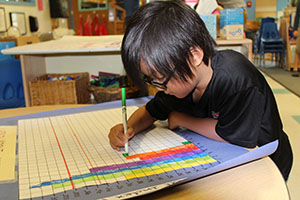
Energy! Blue Room Summer Camp 2018 |

Week Three
Pizza Box Ovens- The ovens made the previous week, were tested out twice this week. First with s'mores and the next day with nachos. The oven was able to melt the chocolate and cheese, and the marshmallow somewhat. A multimeter, borrowed from an engineer parent, tested the temperature to over 50 degrees centigrade. One girl made her own solar oven with stones that were on the playground. She added some black paper and foil and was able to successfully melt a crayon!

Yoga- Ms. Bowman, CYC teacher, certified yoga instructor, and camp administrator, delighted the class with a yoga lesson. She was able to tie it all into our body energy lesson and she even found some poses for the children to do that could help "energize them". One of the favorite parts of the yoga class came at the end when Ms. Bowman carefully placed a Beanie Baby on the backs of each child as they sat in Child's Pose and breathed. Later the children held their Beanie Baby on their tummies as they finished some final breathing exercises.

Wind Tunnel- After swimming, campers walked down Stadium Drive to the Glen L. Martin Wind Tunnel. There Dr. Andrew Lind met the Blue Room and showed the children a map of where they would be going in the building. First a model of the wind tunnel was shown so that everyone could understand how the machine worked. A large fan blew though the tunnel with a model plane that sported tufts of material which fluttered in the wind. Ben Strobel showed the children how the tufts changed according to how he rotated the airplane. Strobel talked about the many things that are tested in the tunnel including the item that was there this day, a box. He explained how the wind blew through in a vortex similar to that of a toilet.

The camp music teacher, Ms. Ojukwu, brought her guitar and drum in and talked to the children about how sound makes waves and how their voice worked. She showed pictures of vocal cords and amazed the children by singing a bit of opera, which she is trained in. She compared the guitar to that of a human bosy and had the children put their hands on their chest to feel the air coming in and out. Before she left Ms. Ojukwu, did an experiment by trying to get rice, that whas sitting on top of a plastic stretched over a bowl, to vibrate. First the drum, then her voice, and finally the guitar made the rice visibly vibrate to the astonishment of the children.
Sound and Music Instruments- Heyni Solera, a graduate student from the ethnomusical department at the UMD, came to share her bandoneon and talk about how it produces different sound. She opened the instrument up to show the children the reeds inside and explained how the bellows were squeezed to make the sound. Solera demonstrated how she created many different sounds with the bandoneon just by vibrating different parts of her body, such as her knees and wrists.

Teacher's Corner
Science 1.0 Use tools such as thermometers, magnifiers, rulers, or balances to extend their senses and gather data.

Testing the heat in their pizza oven with a multimeter.
Comprehension and Collaboration: SL.1.1 Participate in collaborative conversations with diverse partners
Conversation is a big part of everyday. Each group meeting allows time for children's ideas to be shared and questions asked. Children know that a "quiet hand" will be called on in turn. In the afternoon campers enjoy sharing projects they had been working on during the day. Two comments and questions from their peers keeps the discussion rolling.
1.MD.C-Represent and interpret data

Each day children keep track of the heat index number on a chart. They know that if the temperature goes beyond a certain degree that their outside time is limited.
Standard 6.0 Nutrition and Fitness Students will demonstrate the ability to use nutrition and fitness knowledge, skills, and strategies to promote a healthy lifestyle.
While learning about ATP and the energy your body makes, children were taught that sugar gives a quick rush of energy that does not last. It is best to eat carbohydrates. Children looked at their food packaging and charted the amount of calories, carbohydrates, and sugars in their foods.

Building 381, 4028 Valley Drive College Park, Maryland 20742